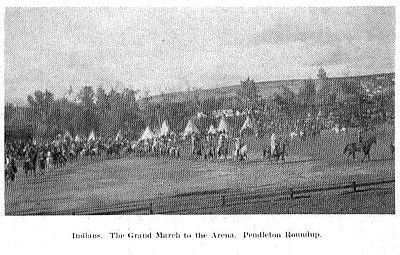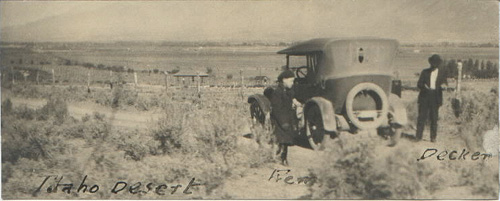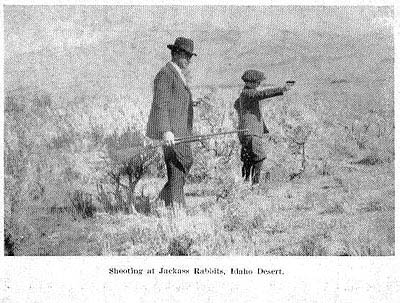CHAPTER IX
We had tickets on the Newspaper
Special train from Portland to Pendleton, Oregon, to attend the famous
roundup. We left at 11 at night. The special trains have their own
dining cars and come from all the large western cities and the south,
as the western people consider the Pendleton Roundup the biggest show
on earth, and it is.
Pendleton is not a large place; only about 6,000, but they started the
roundups there a good many years ago and the world prizes are given
there, so that it is the best of them all. They run all the special
trains in a big railroad yard and they stay there all the time of the
show. They have electric lights all around and they live in the
sleeping cars and eat in the dining cars.
The first day we were there they told us there were 35,000 people the
show and the next day about 30,000. The governors of the next states
were there and all the other officials. One newspaper had an airplane
bring the papers from Portland every few hours.
Every forenoon they practice in the grounds and get ready for the
contests in the afternoon. The big show opens at 1 o'clock and ends
about 6 o'clock.
The arena is like a big fair ground with a grandstand along one side
and bleachers around the rest of the way; I think the reserved seats
cost $5 apiece. Besides all, the people that come in on special trains
all the other trains bring in loads from all around for 1,000 miles.
The Indians come from all over the northwestern states, too. They put
up their teepees and live outside of the town and all of them have
ponies and every day they have a grand parade in the town on their
ponies; they told us there were about five or six thousand of them
there and they all dressed up in their finest beads and feathers when
they came on parade with their ponies all dressed up like themselves
with feathers and colored ribbons in their manes and tails and beads on
their saddles and bridles. The big chiefs all wore war bonnets and
moccasins and beaded war coats and the squaws and children had the
finest buckskin gowns of beads and elk teeth and they sometimes wore
one feather in their hair. All of the Indians were painted and some did
not have any saddles. One old chief was nearly a hundred years old.
They made a big noise when they came down the street.
When they open the show they give a grand parade with the Governor in
the lead and the officials then the cowboys and cowgirls and the rough
riders and guards and then the Indians all on horses. This is a great
sight with about the whole arena filled with them marching. Such a
sight cannot be seen anywhere in the world except here. The Indians are
all rich, for they own lots of land which they rent to the white
ranchers. They own the country around there which is good land for
wheat; it is the Umatilla Reservation. Besides these Indians the other
tribes come from Washington and Idaho, Montana and Utah and Wyoming and
Colorado. The business man on the corner told us that the dresses and
regalia of these Indians were worth $2,500 apiece. They sure did make a
great appearance. I never saw so many different colors.
The contests were Busting the Broncho, Bulldogging contest, Roping
contest, Trick Riding contest, Pony Express, Relay Race, the Roman
Standing Races, the Stage Coach Race, the Indian Bareback race and the
last act was breaking wild horses.
They would first let out a wild steer for the bulldogging contest and
one cowboy would begin the chase on horseback; when the steer and the
cowboy were running as fast as they could go the cowboy would jump from
his horse and land on the steer grabbing it by the horns. He must hold
on one horn in each hand until he gets the steer stopped and twist its
neck until he gets its back with the horns stuck in the ground and hold
him there with his legs with his hands free. If he gets it done in the
shortest time he wins the prize. There were about 10 cowboys in the
contest of bulldogging. One of them was nearly killed. When he made his
leap for the steer and caught him by the horns the steer tripped and
swung against the fence, striking so hard with his head that it broke
the fence, and in the meantime his foot caught in the stirrup and the
horse turned to run away from the mad steer with the cowboy dragging
under his feet and striking the fence every few feet until they all
thought he was killed. They got a stretcher and carried him away and
started the next steer. They carried off four in that afternoon who
were so badly hurt that they could not come back to take part in the
contests.
One of the boys was killed the next day in the wild horse contest. The
roping contest is not so dangerous as the bulldogging. They let loose
one of the long-horned steers and the cowboy must follow him on
horseback until he gets close enough to throw his rope. If he gets him
around the horns the first throw his pony turns quick and the steer
comes down ker plunk on his side; then the pony must stand and pull
with the rope hitched around the pommel of the saddle while the cowboy
jumps off and runs and ties the steer by the legs—all four legs
together. The prize was won in about 50 seconds. Sometimes the steers
are jerked so quickly that it breaks their necks or legs. When this
happens they drag them off and butcher them and give them to the
Indians.
The Bucking Horse contest is sure rough sport. There are two or three
going at one time; they get the wildest ones they can for this and it
takes about four men and four horses to get the saddle on one of the
buckers. They have to blindfold him and tie him to other horses to get
the saddle on. When the cowboy gets on his back they all let go and
away he goes, jumping and pitching and kicking and bucking, now on his
hind feet and then on his front feet, sometimes forward and sometimes
sideways and backward. If they don't fall over backward and kill the
rider they get him off in a few minutes. If he sticks for three minutes
he is given a prize and the guards rush in and lasso the horse and get
him off. If the horse gets him off he doesn't win a prize. It is no
place for timid people.
While they were trying to get the saddle on one of the bad ones he
jumped onto the next horse's back and pretty near got away. The rider
does not try to hold the reins of a bucking horse—he just lets his arms
free and yells and holds on with his legs.
The relay race was very exciting; every round they had to stop and
change horses and saddles; it was a bad mixup when six or seven riders
and horses all stopped in one spot to change horses and saddles in a
few seconds. The trick riding was better than any circus. One fellow
turned around under his horse and back on to the saddle while the horse
was in full gallop as fast as he could run, and another fellow stood on
his head on the saddle while the horse was going full clip.
(The End)
|



